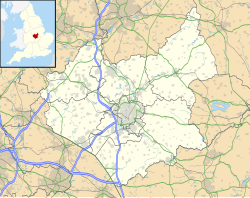Rothley Preceptory

The Templar Chapel built c.1240; incorporated into a later building
|
|
| Monastery information | |
|---|---|
| Other names | Rothley Temple |
| Order |
Knights Templar From 1313: Knights Hospitaller |
| Established | c.1231 |
| Disestablished | 1540 |
| Mother house | from c.1371: Dalby Preceptory |
| Site | |
| Location | Rothley, Leicestershire |
| Coordinates | 52°42′20″N 1°08′52″W / 52.7056°N 1.1478°WCoordinates: 52°42′20″N 1°08′52″W / 52.7056°N 1.1478°W |
| Visible remains | The Preceptory's chapel and part of the domestic buildings still remain as part of the Rothley Court Hotel. |
Rothley Temple, or more correctly Rothley Preceptory, (pronounced Rowth-Ley) was a preceptory (a religious establishment operated by certain orders of monastic knights) in the village of Rothley, Leicestershire, England, associated with both the Knights Templar and the Knights Hospitaller.
The preceptory's chapel, constructed by the Knights Templar, is currently part of the Rothley Court Hotel.
Rothley Preceptory was established around the year 1231; however, records show "The Poor Fellow-Soldiers of Christ and of the Temple of Solomon" (more commonly known as the Knights Templar) owned land at Rothley as early as the reign of King John (1199–1216). On the establishment of the preceptory King Henry III granted the Knights Templar the manor and church at Rothley. The preceptory would come to own land in 13 neighbouring villages, including granges used for farming at Baggrave (near Hungarton) and Gaddesby. The knights of the preceptory also owned the Manor at Gaddesby.
Around 1250, the preceptory was recorded as having a yearly revenue of £62. 10s. 5d., which was used to help fellow Knights Templar in Acre, in modern-day Israel.
In 1284, King Edward I granted the preceptory's knights a charter, permitting them to hold a weekly market, on a Monday, at Rothley, and an annual fair in honour of Saint Barnabas each June. This lasted until 1306, when King Edward issued the knights with another charter permitting them to hold a market and festival at their manor at Gaddesby, instead of at Rothley. This charter afforded a weekly market on a Wednesday and an annual festival in July in honour of Mary Magdalen.
After losing the Holy Land in 1291, the Knights Templar lost purpose, power and influence, and were forced to move their headquarters to France. Shortly after, King Philip IV of France, heavily indebted to the order, started a campaign against the Knights Templar, using his puppet Pope Clement V. King Philip had Pope Clement arrest the Templars for various offences, including: apostasy, idolatry, heresy, obscene rituals, homosexuality, financial corruption, fraud, and secrecy. Under torture, many confessed.
...
Wikipedia

